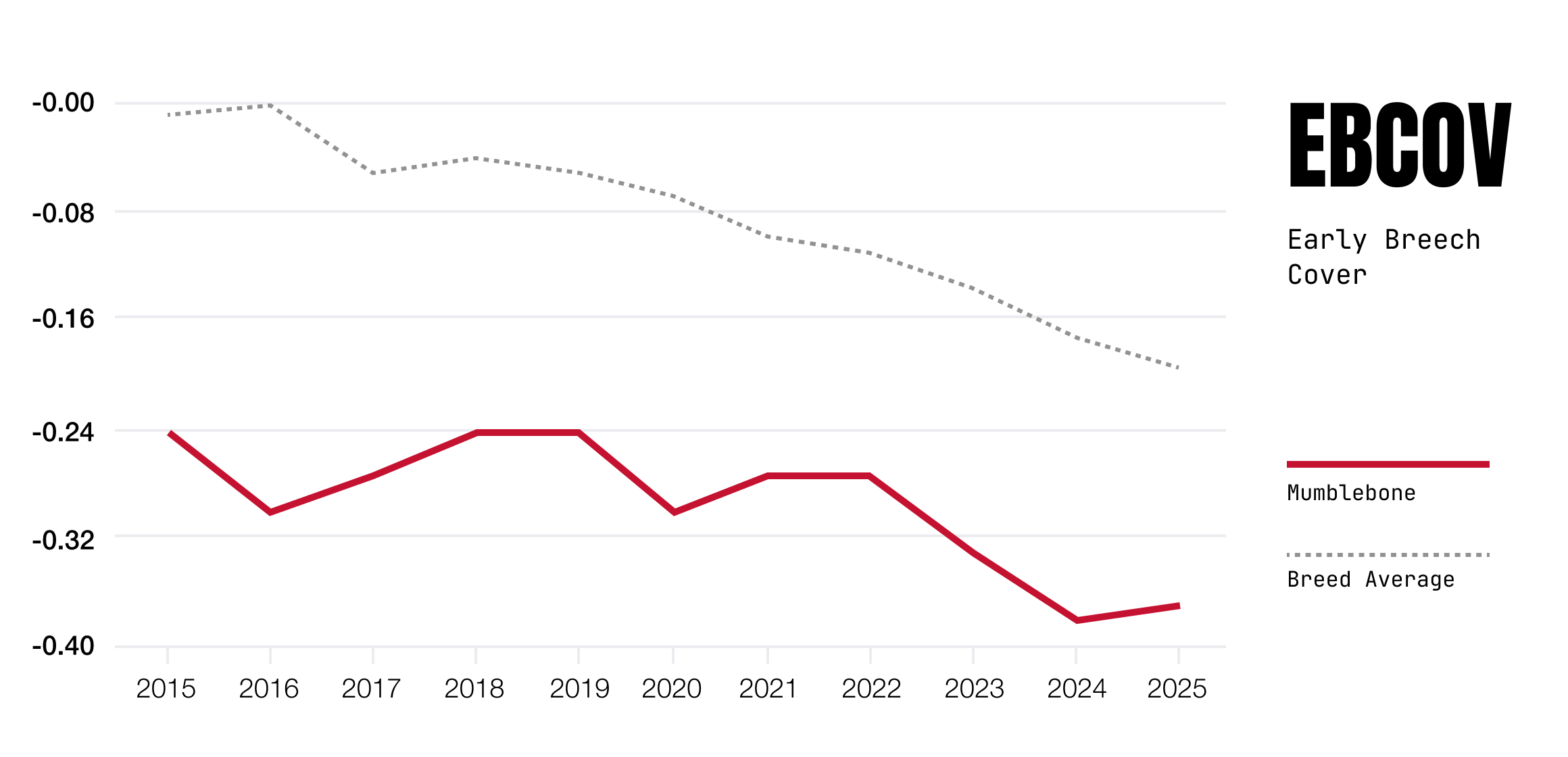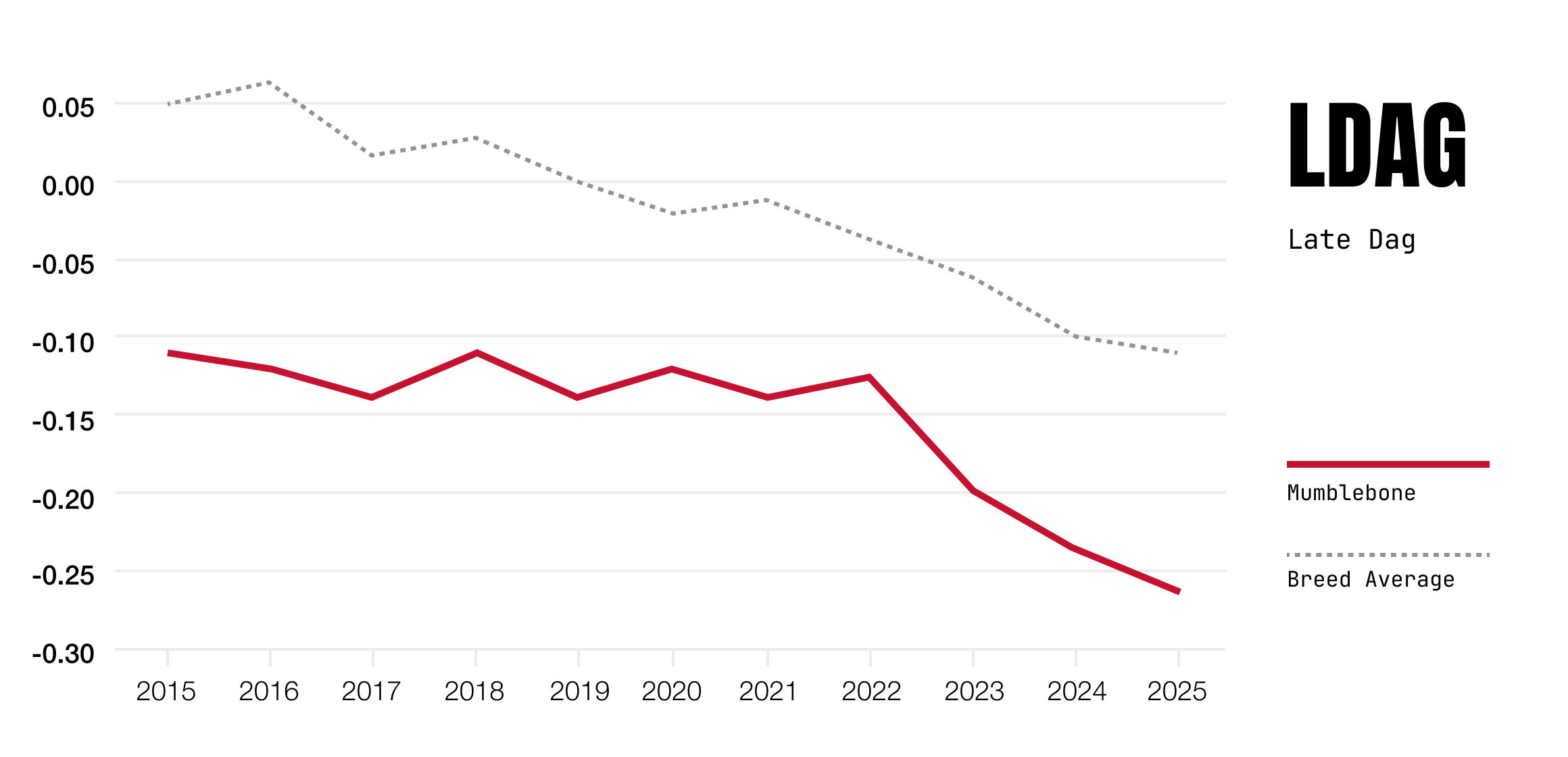Our welfare philosophy centres around aligning production goals with consumer needs, emphasising animal welfare as both a driver of productivity and a response to consumer concerns.
Prioritising traits such as early breech wrinkle and worm resistance has bred a highly fertile, easy-care animal that eliminates the need for mulesing while also addressing the issues of fly strike and worm burdens. This combination of genetics, with management, has created a breed of sheep that meets industry demands for both performance & welfare.
Early Breech Wrinkle
EBWR is the first trait to focus on if looking to move away from mulesing.
If your flock is in a dry area, combining EBWR with EBCOV will make the transition very quick.
If your flock is in a high dag area, combining EBWR with LDAG will be the way to go.
Combining all three traits is best if you can.

Correlations of lower wrinkle EBWR
- Higher reproduction
- Less fly strike
- Higher staple strength
- Lower fleece weight
Early Breech Cover
Breech Cover is a trait we have started selecting for more recently to increase the number of traits we offer breeders to better manage their flocks.
EBCOV is a very good complement to EBWR to transition away from mulesing, particularly in dry areas, and also has good correlations to reproduction.

Correlations of lower Breech Cover
- Higher reproduction
- Less fly strike
- Keep an eye on fleece weight
Late Dag
LDAG is a very important trait for people to focus on if breeding sheep in high dag regions like the winter rainfall areas of southern Victoria & parts of Tasmania. LDAG also combines very well with low EBWR in high dag regions to move flocks away from mulesing.
Reducing flystrike & crutching costs are the big wins of low dag sheep as both are important parts of an easy care flock.

Correlations of lower Dag
- Less fly strike
- More fleece wool
- Less crutching
Yearling Worm Egg Count
YWEC is the trait to select if looking to manage your flocks’ worm burdens genetically.
There is usually a trade-off when selecting heavily for a particular trait – “more wool, less lambs’ ‘ is an obvious example. Selection for YWEC doesn’t seem to have any such trade-off, only a positive correlation with muscle & staple strength.
YWEC has become a strength of the Mumblebone sheep. Of the 400 rams offered in 2022, 385 of them had a negative YWEC.

Correlations of Worm resistance YWEC
- Higher muscling
- Higher staple strength
Including welfare traits in our breeding programs is the best way to combine production goals with the needs of our discerning customer.
Ironically, our consumers’ concerns around mulesing & lamb survival fit very neatly into the breeding program of a highly fertile, easy care sheep that doesn’t need to be mulesed, & we would very much like to see our industry move rapidly towards breeding this type of sheep.
Other welfare areas include fly strike, worm burdens & the issues associated with dag. These are all areas we can control through a combination of genetics & management, & the selection of these traits has never been easier now that we have accurate breeding values to select them with.
Animal welfare is both a production driver & a way of meeting our consumers’ concerns.
Early Breech Wrinkle
Mulesing becomes unnecessary once we remove the skin wrinkle from around the tail of our sheep – a labour saving & a way of meeting our consumers’ concerns. Mumblebone ceased mulesing in 2006.
To assist the transition to non mulesed include EBCOV & LDAG in the selection criteria.
Worm resistance
Easier to manage, no chemicals required.
Correlations of Worm resistance YWEC:
- Higher muscling
- Higher staple strength
The more we align our production goals with our consumer needs the easier it is to do business.
We’ve been on Mumblebone genetics for 25 years & have seen continual improvement in our flock over that time – we now mark 40% more lambs, have ceased mulesing & run a flock that can handle the tough times far better. We shear every 6 months & our RWS accredited clip attracts a premium for our non-mulesed wool.
These improvements are a direct result of the measured genetic gains available through the use of industry leading ASBV’s provided by Mumblebone.
A well balanced, productive & easy care animal should be the goal & Mumblebone allows us to breed that sheep. Just don’t judge Chad on his choice of NRL team.
Bonnayr, Curban NSW

